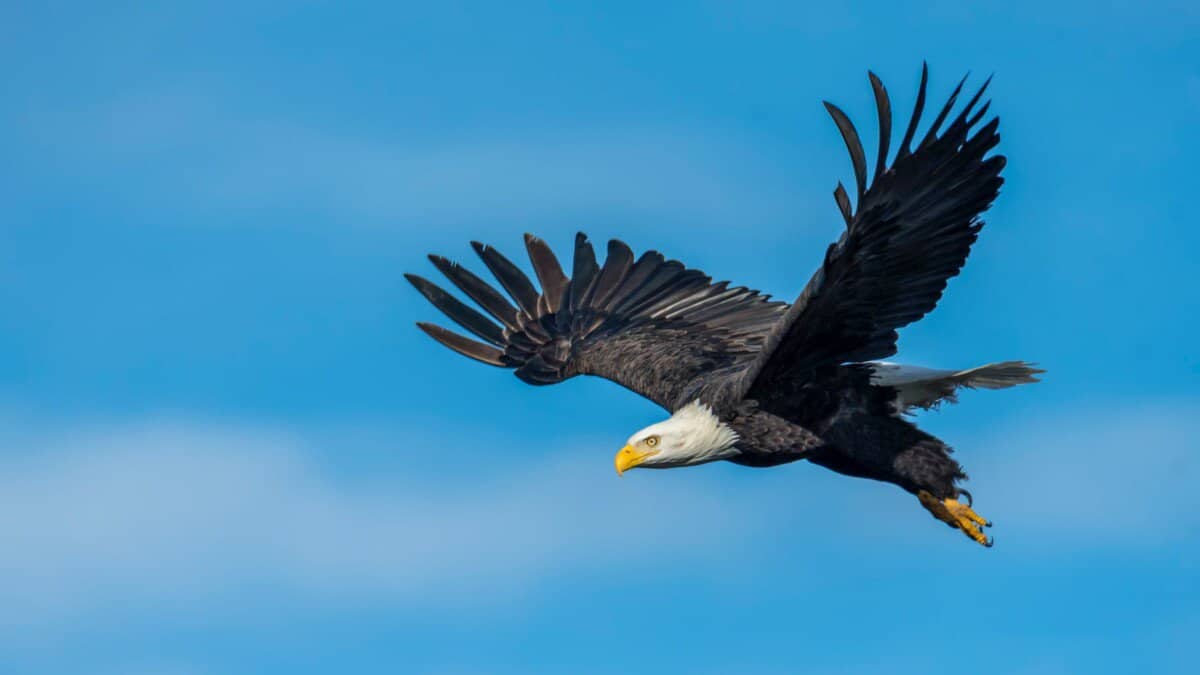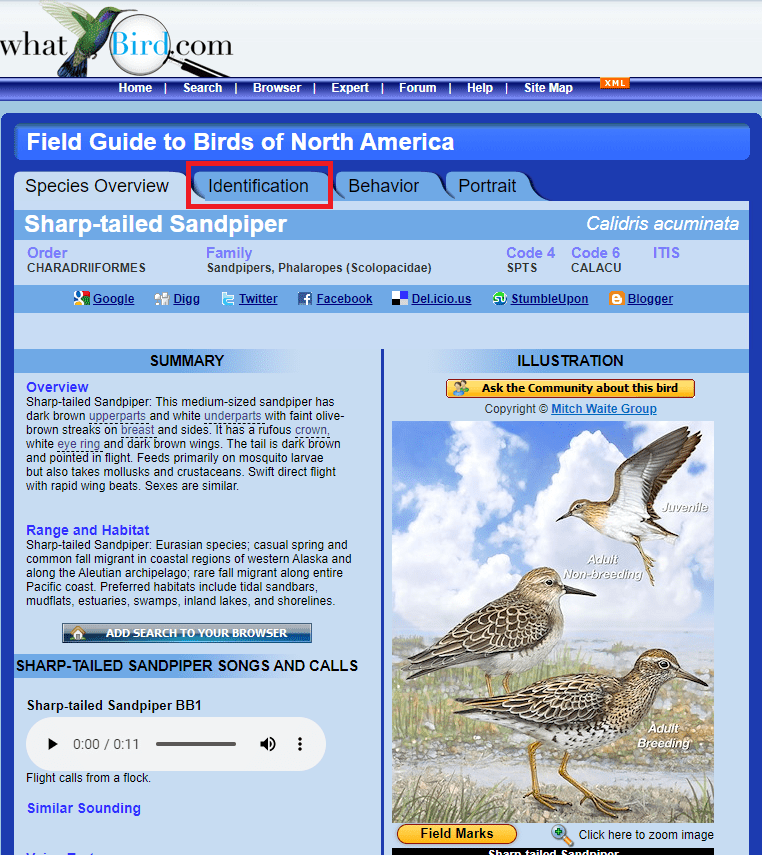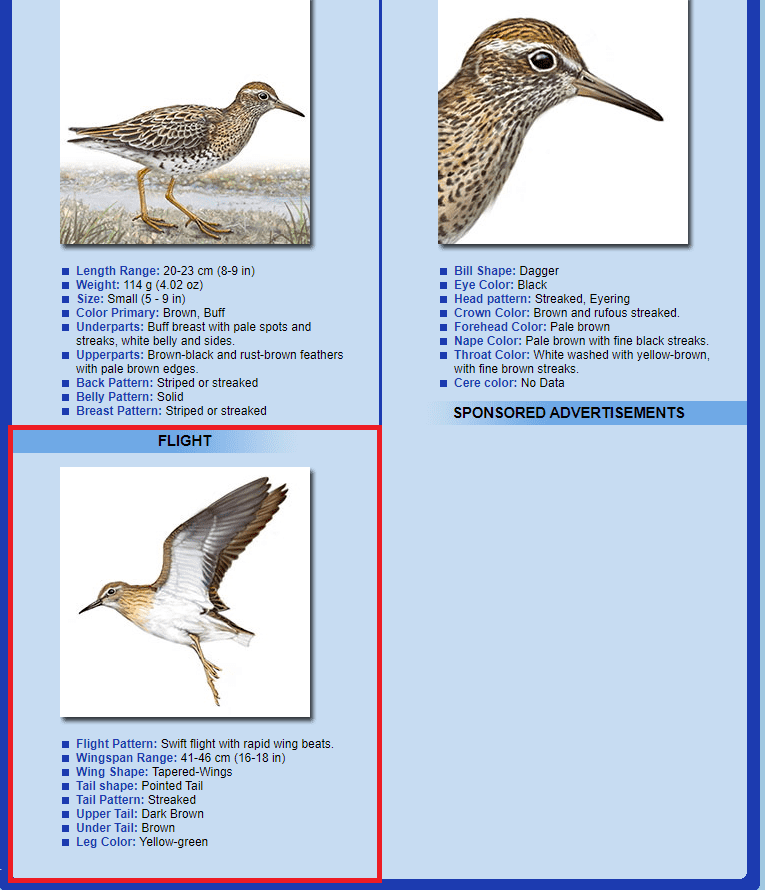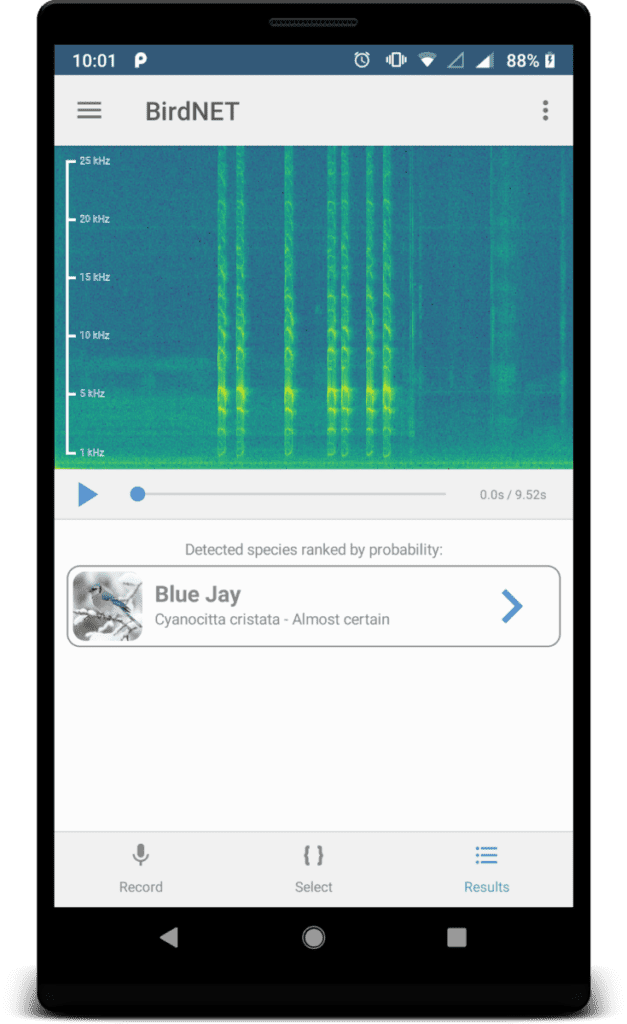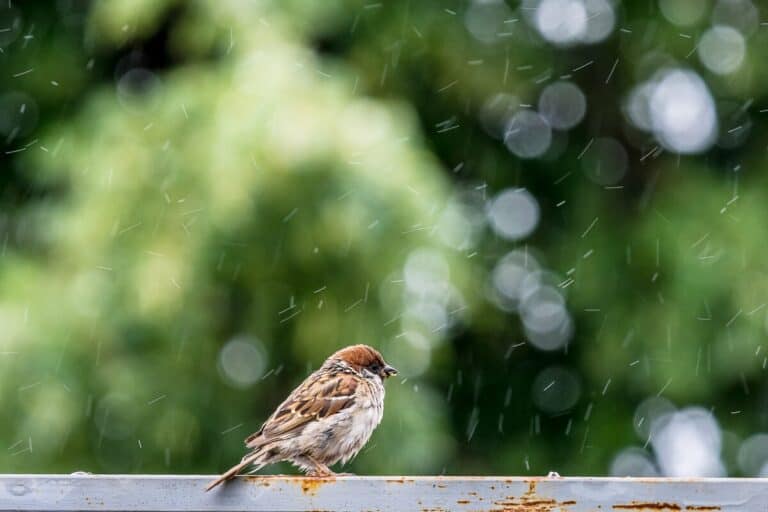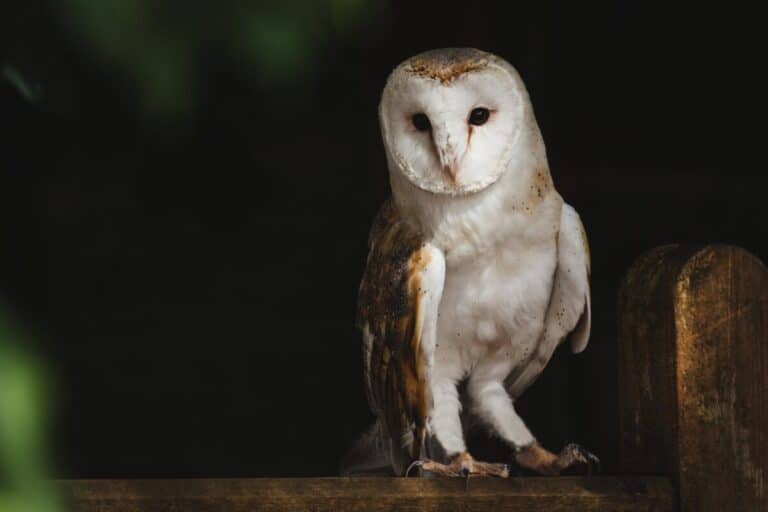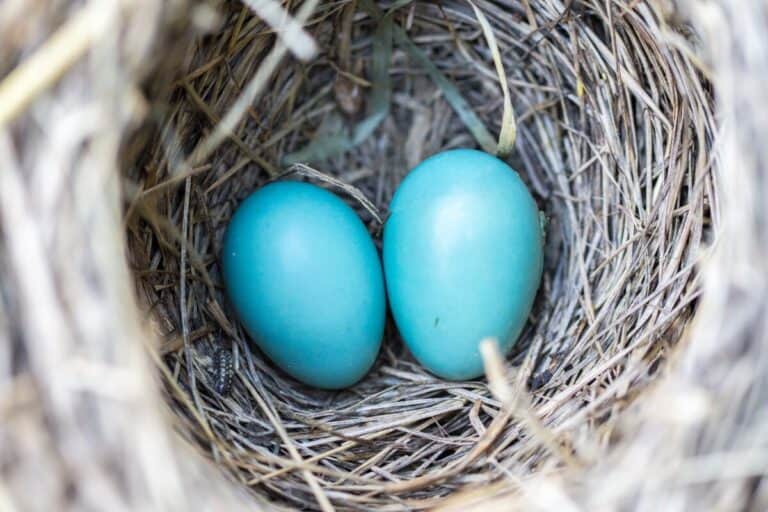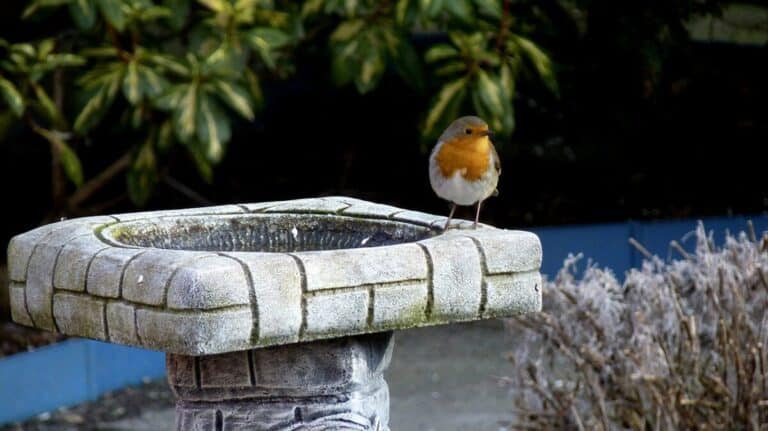9 Best Ways To Identify Birds In Flight (BONUS resources!)
We’re reader-supported; we may earn a commission from links in this article.
You may have experienced this before: You spot a fleeting instance of a bird flying past your field of view and it’s too quick to identify! If you’re facing this exact same problem that I had when I first started birding, you need to learn how to identify birds in flight! Trust me, I’ve been through the same experience as you did, but with some helpful pointers I listed in this guide, you’ll be armed with useful knowledge to get you started!
How To Identify Birds In Flight
- Flight Range
- Habitat
- Behavior
- Flight Altitude
- Time Of The Year
- Flight Characteristics
- Wing Characteristics
- Tail Characteristics
- Bird Sounds
Identifying birds in flight can be a really daunting task, especially if you are a beginner. I must say first that I’m not at all a complete pro, but just sharing some resources that has worked for me to help other people like you were stuck like me! No worries though, I will take you through it all. Now let’s get to it:
1. Flight Range

By learning common birds in your area and their flight range, you will be less likely to get caught off guard when spotting a bird flapping away in the distance.
First and foremost, like learning how to fly a plane, all pilots must first begin to be familiar with their grounds and how their planes look while on the ground. Here’s what you need to begin with first: get familiar with the birds in your area and their flight range! In order to get a better sense of birds zooming by, we need to know what to expect BEFORE we even see one.
Here’s an example. Personally, I know that there is a particular tree that I live next to that has a bunch of birds called the Asian Glossy Starlings. They are a bunch of small greenish-black starlings that love to fly around speedily with lots of flapping in a flock together. I remember this bird vividly as I always walked under a tree near my school with fear as a kid. There were at least 50 of them in that single tree and they would poop all over the place!
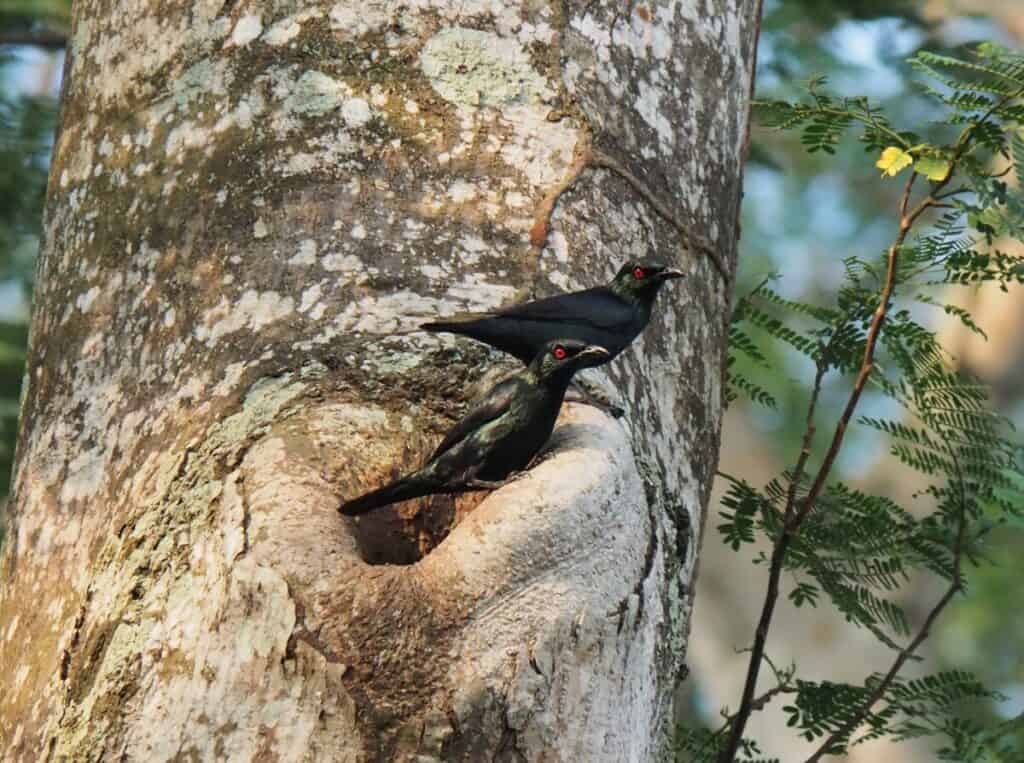
To begin, I first go to eBird, an amazing resource about birds, to find out more about the birds. Then I take a look at their range map. Here’s what the range map looks like:
Okay, so I now know that that the range map extends throughout the southern part of Asia, which is where I live, so I expect to see such a bird! The same thing applies to any bird in your region.
Once you get familiar with the birds in your region, check their range map whether they are commonly seen in your area. This prep work will definitely help you to narrow down your search so you know the birds in your closest vicinity. How can we trust this data? It’s contributed by birders like you and me who log down their sightings in the app itself. So we can be sure that it’s updated with the latest info on birds in your area.
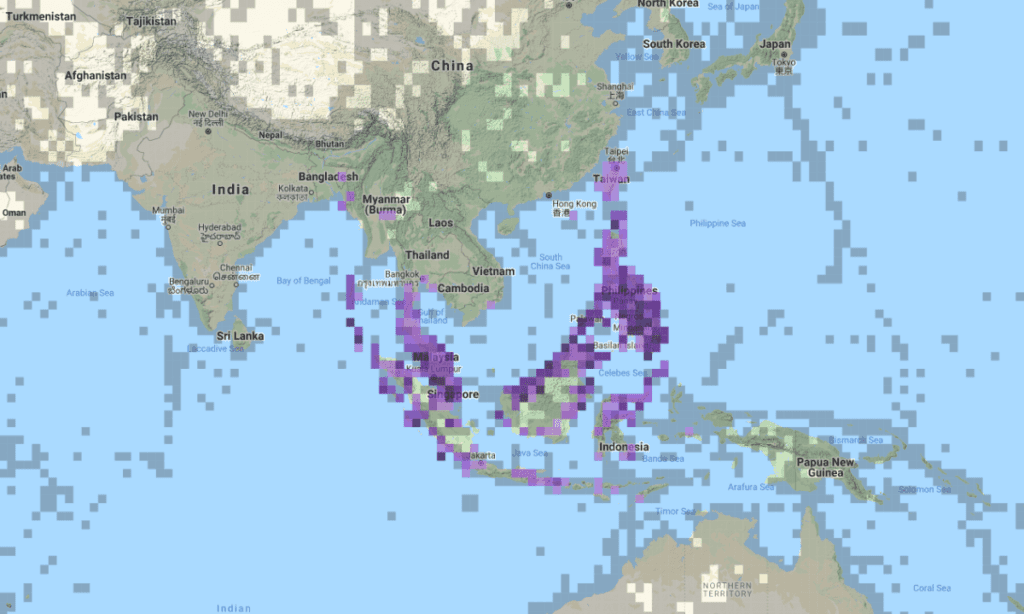
2. Habitat
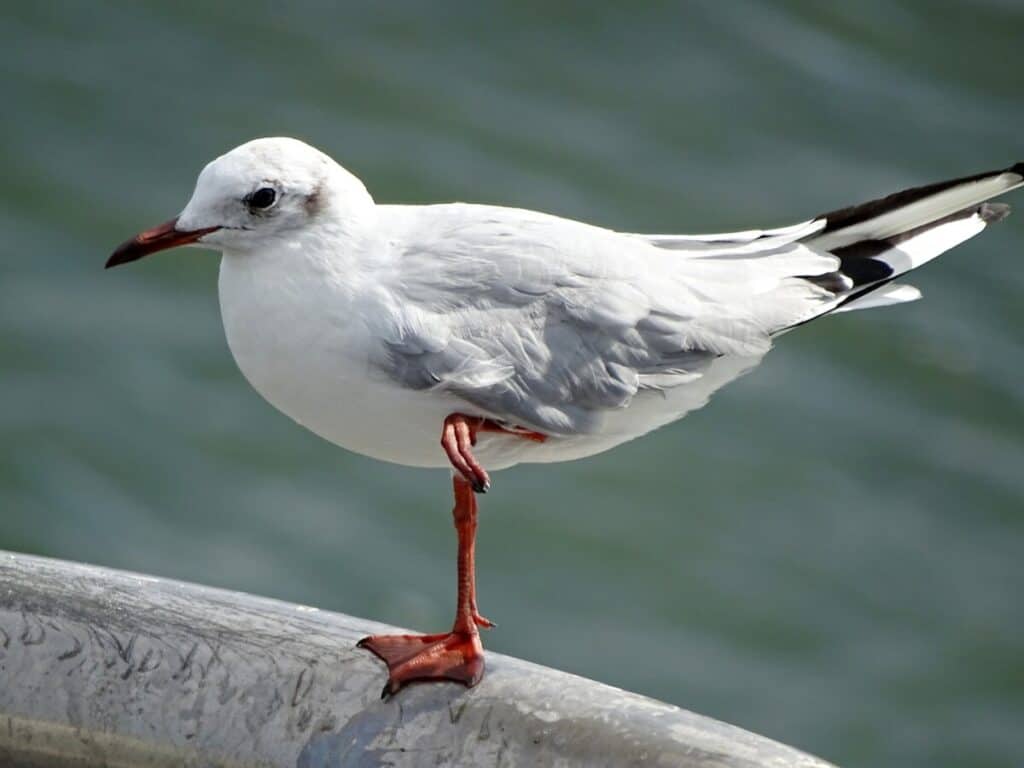
By learning of the habitats of birds where you are at, you can narrow down to a smaller list of birds the bird in flight could be from!
Just like in typical birding, you need to be familiar with the habitat that you are in. Even if you look at the range map, that may be too broad and there may be just too many different bird species that live in your area. The habitat narrows it down to maybe only shorebirds at the beach, pittas at mangrove forests, or tits in backyards.
If you are at the beach, although there are chances for some other birds to be in the area, generally most birds that reside there are going to be shorebirds! Why do you expect shorebirds to be near the beach? They are adapted for the environments there and that’s also where they hunt for food.
Using the example of the Asian Glossy Starling again, it can be found in habitats near fruiting trees and can be found flying in groups near to the trees. Typically, you would not expect to see this bird flying past you at the seaside or at a lake. Here’s a video of them flying around in a flock together:
3. Behavior
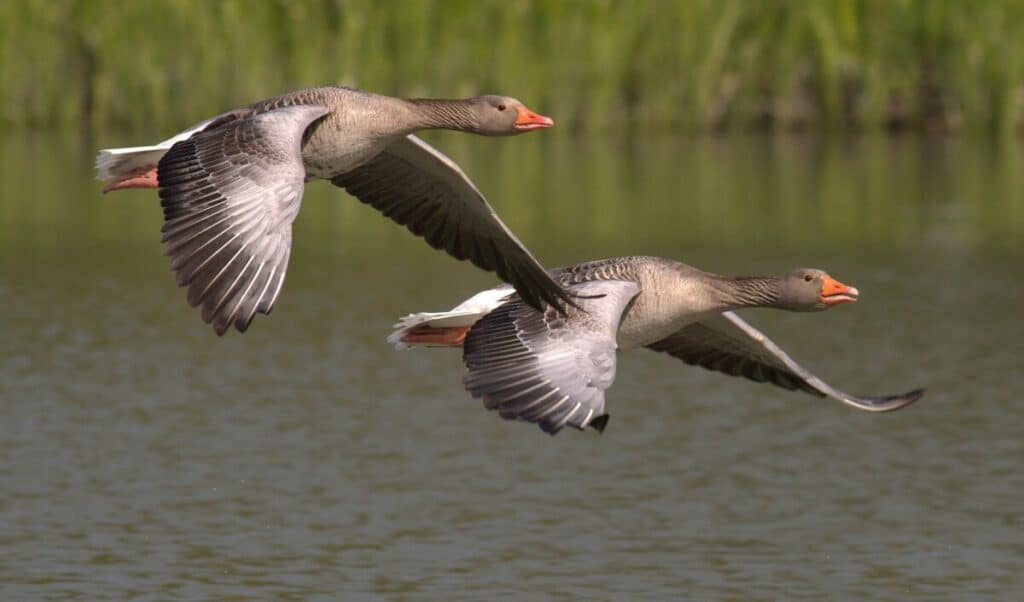
Behavior itself cannot help to determine a bird in flight if it a bird of prey is simply just soaring around in the sky. You may not know the purpose of the flight and the identity of the bird, but it is a crucial clue to what kind of bird it could be.
Okay, let’s say you see a bird flying around in front of you now. I want you to ask yourself: ‘what is the purpose of the flight?’ A deep question right? Well, flight is actually very energy-intensive for birds and they only fly for a reason! Is it for hunting, chasing threats away, gathering nest material, or to court a mate? Their flights can differ based on the purpose of their flight.
Why is knowing birds’ behavior important? It is so that you can differentiate the type of feeding patterns different birds have and rule out those that don’t qualify! For example, if you see a bird flying back and forth on the ground, it could be a myna, starling or a sparrow trying to forage for food on the ground. You would not suspect that the bird would be a swift, which hardly ever touches the ground. In fact, swifts hardly ever perch and are always seen swooping around in circles quickly.
4. Flight Altitude
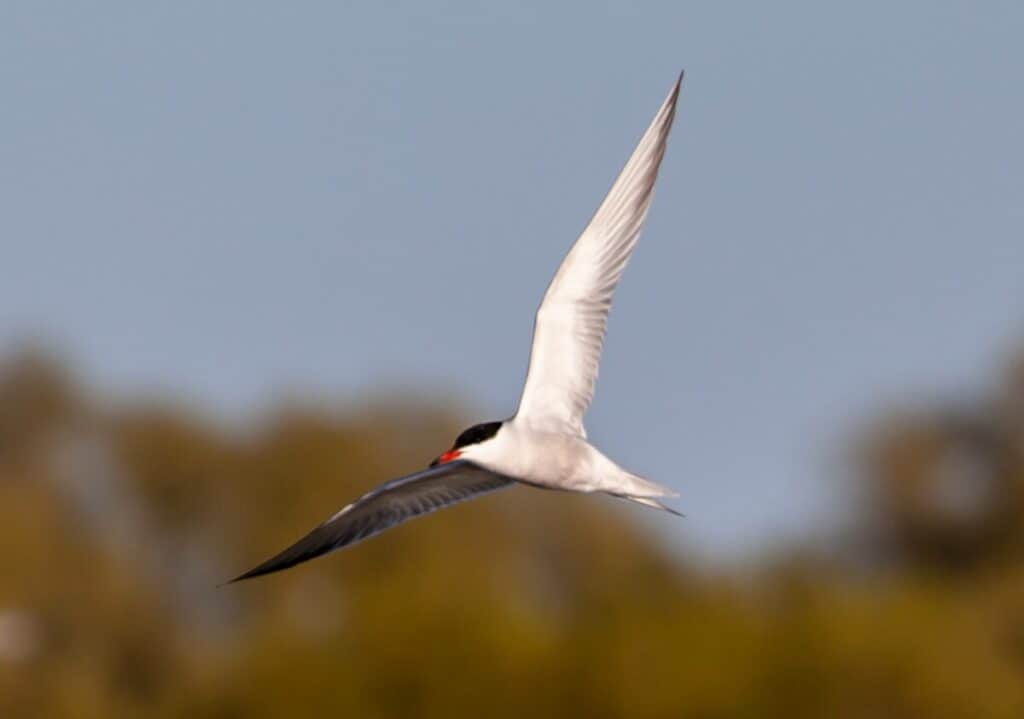
On a similar topic to the behavior of the bird you saw flying, you would also need to consider its flight altitude. Not all birds are born the same: some birds are high-flyers and some are simply not. Different birds fly at different altitudes because they survive well in different environments. Eagles are born to soar high in the sky, whereas the Asian Glossy Starlings were meant to pick up small worms, bugs, and berries from the ground and low trees. Here are some examples of birds that you can see at different altitudes:
| Low-Flying Birds | High-Flying Birds |
| Asian glossy starling: Usually flies from ground to and around low trees for foraging | Rüppell’s vulture: Highest flying birds at 11,300 metres (37,100 feet) [1] |
| House sparrow: Usually seen flying low in cities, neighborhoods, and farms. Lives in bushes | Bar-headed goose: 2nd highest-flying birds that fly over the Himalayas during migration at 10,000 metres (33,000 feet) [2] |
| White-breasted nuthatch: Creeps along tree trunks and branches upside-down. Visits backyard feeders | Bald eagle: US National Bird, flies at just over 3,000 meters, 10,000 feet |
5. Time Of The Year
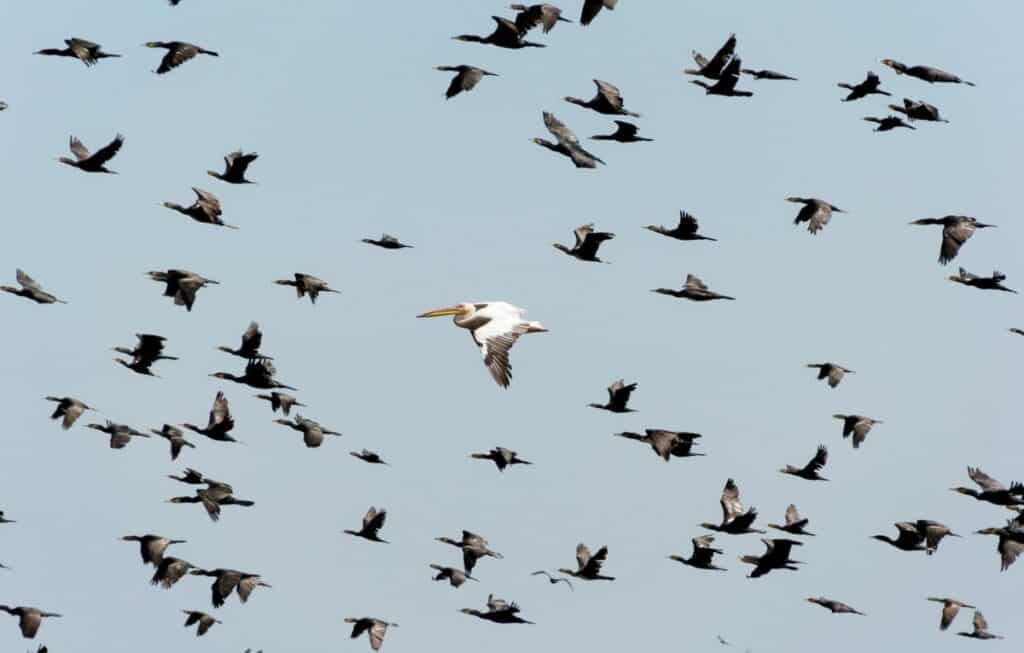
By knowing the time of the year, you can expect to see exceptions to the exemptions in bird flight behavior and flight altitude! Pay attention to the range map of individual birds
The time of the year is got to be one of the most important things you have to look out for when identifying birds. This is because if the time of the year you see the bird also falls in the migration seasons of spring and fall, then you would expect to see more birds flying at a higher height and in larger groups than normal.
During migration, according to the RSPB wildlife charity, birds can fly between 200 and 1,500 meters (650 – 5000ft) above sea level. This means that the altitude at which birds fly can be different from their daily activities. This can rule out the exemptions made in the behavior and flight altitude points before. Migration can also mean that the birds that are not commonly seen in your area can actually be flying over your heads to reach their destination! This means that you never will know whether another rare species from another area may visit your vicinity. This is why the range map I mentioned above is so important!
6. Flight Characteristics
In a split second when a bird flies by, you need to decipher as much information as much as possible if you want to ID the bird correctly. One way to do it is by the characteristics of its flight.
Flight Patterns
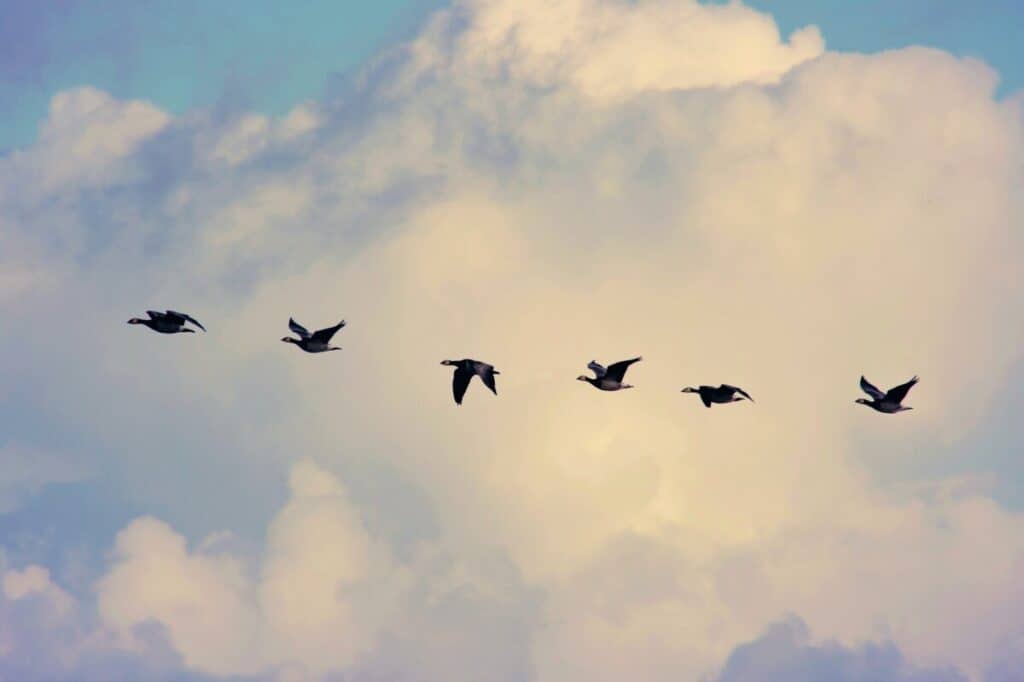
The easiest and most obvious way of identifying birds that fly very quickly is by their flight pattern. Different birds have vastly different methods in the way they fly. Here are some common bird flight patterns:
| Bird Flight Pattern | Description | Examples of bird species |
| Direct | Bird flies in a straight line without losing height by flapping their wings continuously | Shorebirds, starlings, herons |
| Hovering | Bird flaps its wings rapidly to stay in place, without moving in any direction. | Hummingbirds, kingfishers, kestrels, terns, hawks |
| Undulating | Bird flaps its wings quickly to gain height, then glides as it descends in height. Bird looks like it’s going up and down a rollercoaster track. | Finches, orioles, sparrows, woodpeckers |
| Glide | Bird flaps minimally then glides for most of its flight. | Swifts, swallows |
| Flap & Glide | Bird flaps their wings more frequently, alternating between flapping and gliding equally. Height remains constant in flight | Owls, ibises, shearwaters |
| Straight-line formation | Birds fly together and form a straight line in their flight path, with one behind another, like waiting in a line (queue). | Pelicans, flamingoes, cranes |
| Static soaring | Bird spreads out its wings, utilizing the thermals of midday to fly in circles and gain altitude | Eagles, falcons, vultures, hawks |
| V formation | Birds fly in the shape of a ‘V’ with a lead bird at the tip of the ‘V’s. Used in migrations to significantly improve energy efficiency. | Geese, migratory birds |
| Moth-like | Bird flutters its wings to make minute and quick changes in direction in its flight. Looks like a random flight pattern like that of moths. | Owls, nightjars, nighthawks |
Flock Size

When birds are in flight, they do not always fly alone: some fly in flocks. Not all birds have flocking behavior though! If you are looking at a bird that is flying in a flock, you can immediately rule out the birds that can be typically found flying alone. However, this doesn’t apply vice versa, as a flocking bird can still be found flying alone in some circumstances.
Examples of common flocking birds:
- Blackbirds
- Starlings
- Shorebirds
- Robins
- Flamingos
- Cranes
- Pigeons
7. Wing Characteristics

We’ve looked at all the macro stuff already, now let’s dive into the details. When observing birds from below, we can often see the full wingspan or silhouette of birds. If you aren’t new to birding, you might already know how to recognize birds from their perched appearance. Now we need to advance a little further by observing its in-flight appearance too: we look at its wings!
(a) Wing size and shape
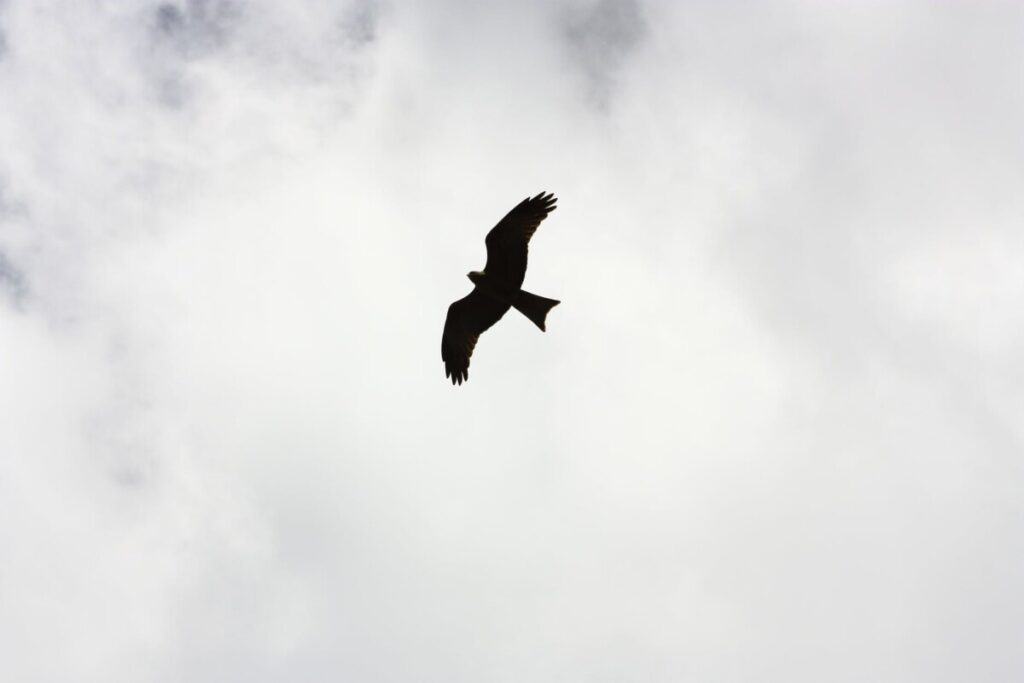
Take a look at the wing size. If the bird looks to have a wide wingspan, then it definitely isn’t a small bird, so you can rule that out. Try to match the wingspan and size of the bird in flight with your knowledge of the bird’s typical size when it is perched.
Observe its shape carefully. Is the head round? Are the wings pointed or not? For simple smaller, low flying birds, it is easy to determine its shape. But what about those birds that fly high in the sky and are difficult to spot? With a pair of binoculars, you can probably only see its silhouette at best.
High-flying birds (raptors) that soar in the sky have very similar-looking plumages and it is very difficult to tell the difference between them; so most bird experts use the shape of their wing feathers in flight to differentiate them. More specifically, its primary feathers. The primary feathers of a bird are the ones that are the ‘fingertips’. They are actually used very often in raptor ID cases as there are minor nuances that can be picked out when looking at them from such a far distance!
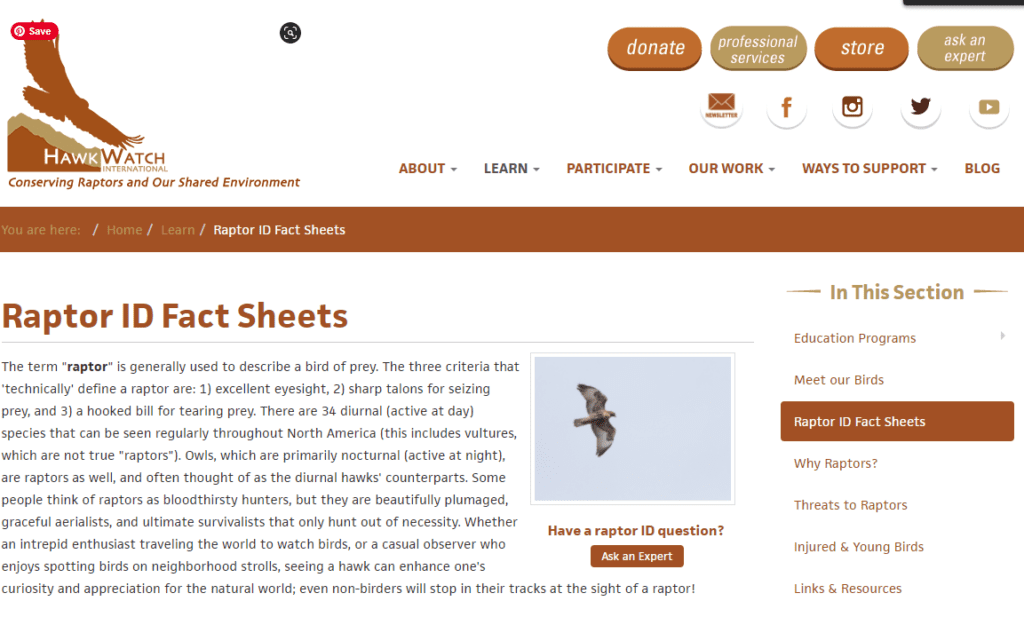
If you’re interested to learn more about raptor/birds of prey identification, head over to Hawk Watch for more information from experts there. You can also download their app: Raptor ID on both the iOS app store or Google Play Store. It’s a great app for comparing raptors in flight!
You can also check out this website for raptor ID tools like identification charts, common raptor silhouette guides and more!

(b) Wing plumage
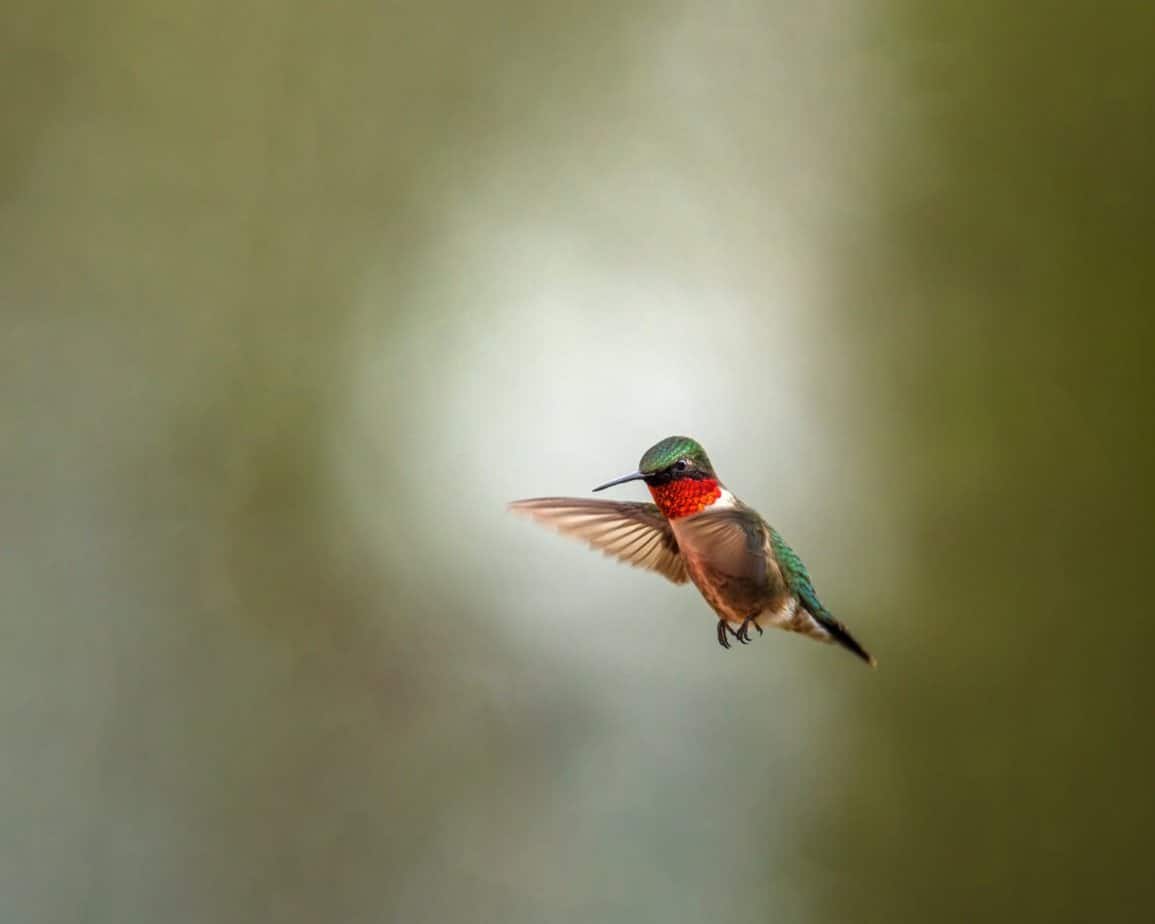
When seeing a bird fly past you, you have to try to notice its plumage. Though plumages of birds may change during the change of season, it is still important to quickly glance and determine its color. If you can do so, you may have a chance at identification using the elimination method in the Merlin Bird ID app. If you’ve never used this app before, you GOTTA download it! It has a superb function that takes you through a questionnaire to ask about the bird in question to derive a final list of possible birds. From there, you can narrow down it further by confirming with the bird you see with the pictures in the app. (it’s free!)
8. Tail Characteristics
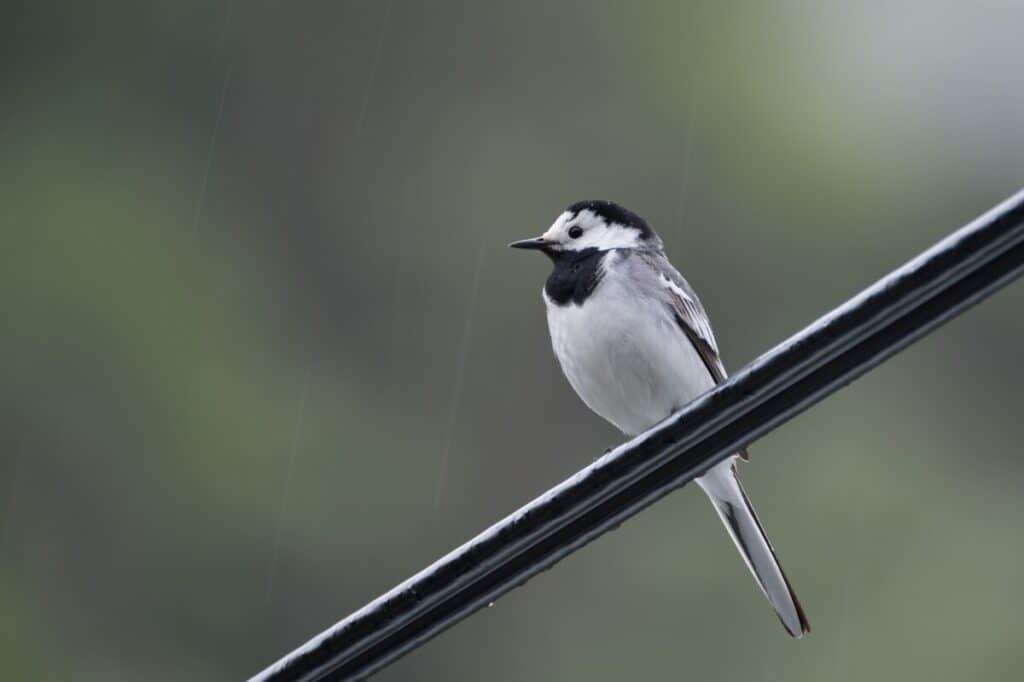
When looking at a bird in flight, you usually will look at it from below. In this perspective, what’s the most obvious? The tail! When you have so few details about a bird that flew past, you need ANY information you can get; including its tail. Bird tails can come in different shapes, so you need to narrow them down to lead you to a list of possible birds. Here’s a table of different bird tail shapes and respective birds that have them:
| Bird Tail Shape | Bird Species Examples |
| Fan-shaped tail | Blue jay, American kestrel, Prairie falcon, Bald eagle |
| Rounded tail | Barn owl, Common loon, Turkey vulture, Killdeer |
| Forked tail | Barn swallow, Common tern, Ashy storm-petrel, Carolina chickadee |
| Squared tail | Western screech-owl, Red-shouldered hawk, Wood stork, Peregrine falcon |
| Notched tail | Wedge-rumped storm-petrel, Reed bunting, Asian brown flycatcher, Japanese bush-warbler |
| Unique tail | Pomarine jaeger, Red junglefowl, Rainbow bee-eater, Chestnut-winged cuckoo |
| Pointed tail | Mourning dove, Acorn woodpecker, Greater sage-grouse, Sharp-tailed sandpiper |
I HIGHLY recommend that you check out this really cool website that sorts birds by its tail categories, similar to the 6 above: whatbird.com You’ll see in the link how you can select a particular bird tail type, then look through the beautiful descriptions and illustrations of birds in a nice list. You can narrow down your effort from there.

If you click on a particular bird, let’s say the Sharp-tailed Sandpiper, click on the ‘identification’ tab on top, then scroll down to the section on its flight. You can then see more details on the bird during flight. How cool is that?
9. Bird Sounds
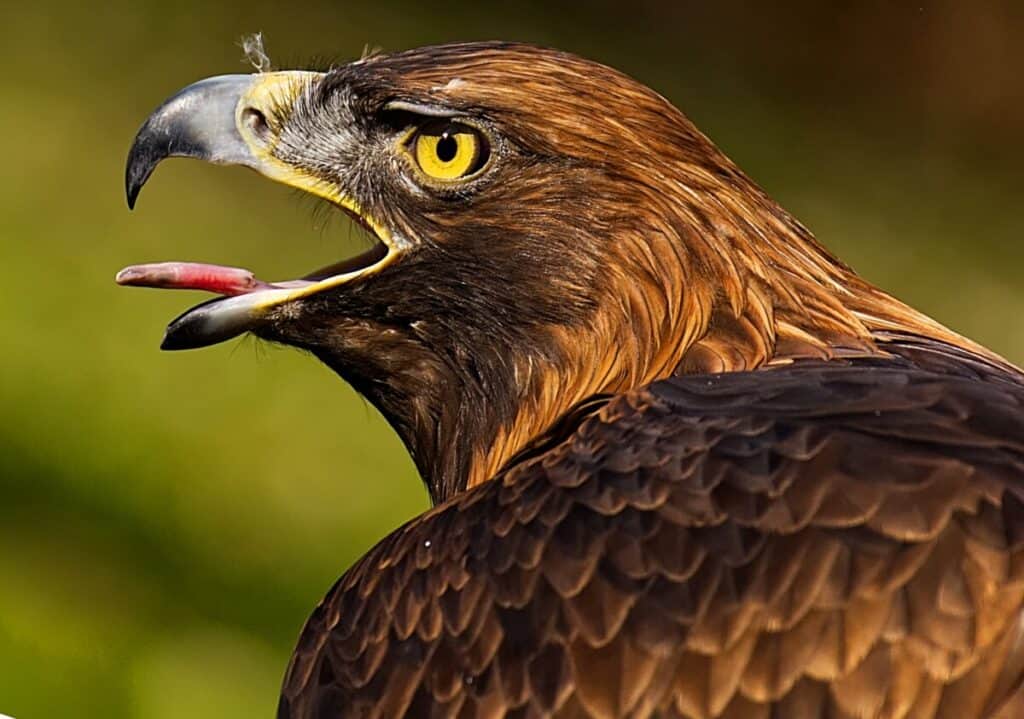
Birds also make calls and sounds during their flight! If you haven’t realized, birds have specific calls that they use only for flight! They are called flight calls! Here’s a video of tree swallows flying and making flight calls in a flock.
Now you must be wondering, but what if I don’t know how to identify them by their calls? No worries, I have the best tool to share with you: BirdNET. BirdNET is an app that uses artificial intelligence (AI) neural nets to listen to bird sounds around you to predict the identity of those birds! The best part about it is that it’s free and available for both iOS and Android.
I personally use it VERY often to identify birds by sound! You can learn how to use it here:
Resources For Identifying Birds In Flight
I’ve taken some time to compile ALL of the tools, resources, and helpful guides to help you learn to identify birds by their flight. Here are some of them I enjoy:
1. Birds In Flight ID Guide
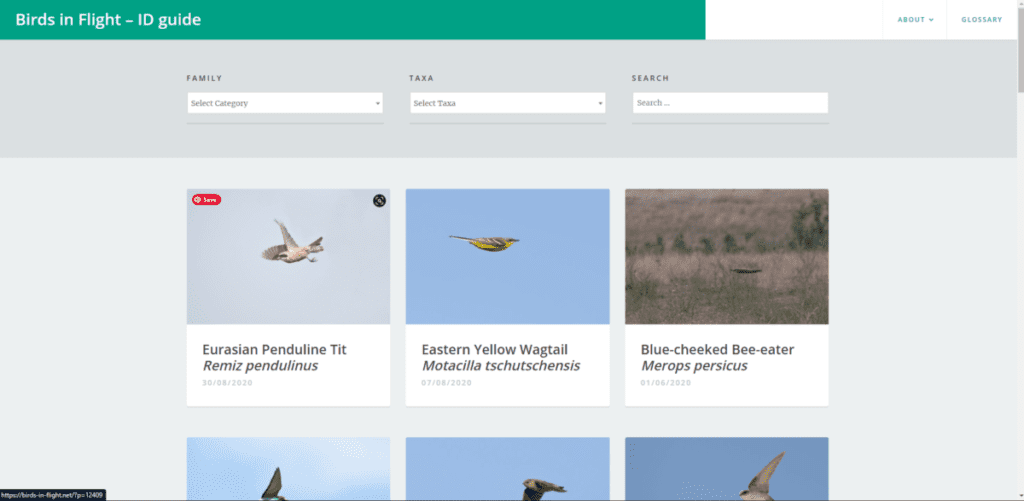
This ID guide is a perfect tool for anyone learning how to recognize and identify birds by their flight. It’s a web app that is a repository of pictures of birds in flight. It has a great sorting function and a great search function. Definitely check it out!
Link: https://birds-in-flight.net/
2. Learn Bird Flight Patterns By The Museum Of Science
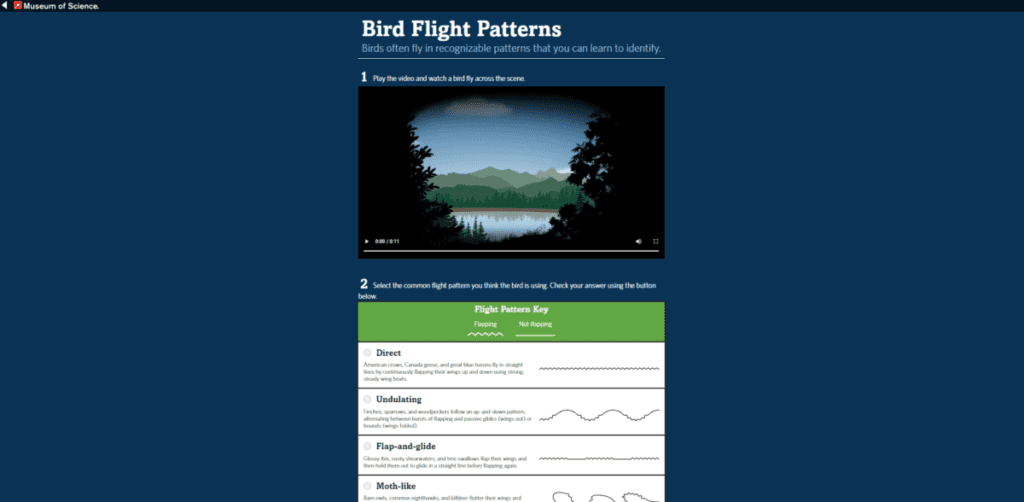
This website is an amazing learning tool that helps to solidify and educate new birders on the basic forms of bird flight patterns: direct, undulating, flap-and-glide, moth-like, and static soaring. It gamifies the process of learning and it’s really interactive: you have to select the appropriate flight pattern shown in the video. The musical notes played really help to reinforce the learning and wingbeats! I HIGHLY recommend trying this!! No kidding, it’s a hidden gem!
Link: https://virtualexhibits.mos.org/bird-flight-patterns/
3. Learn To Photograph Birds In Flight
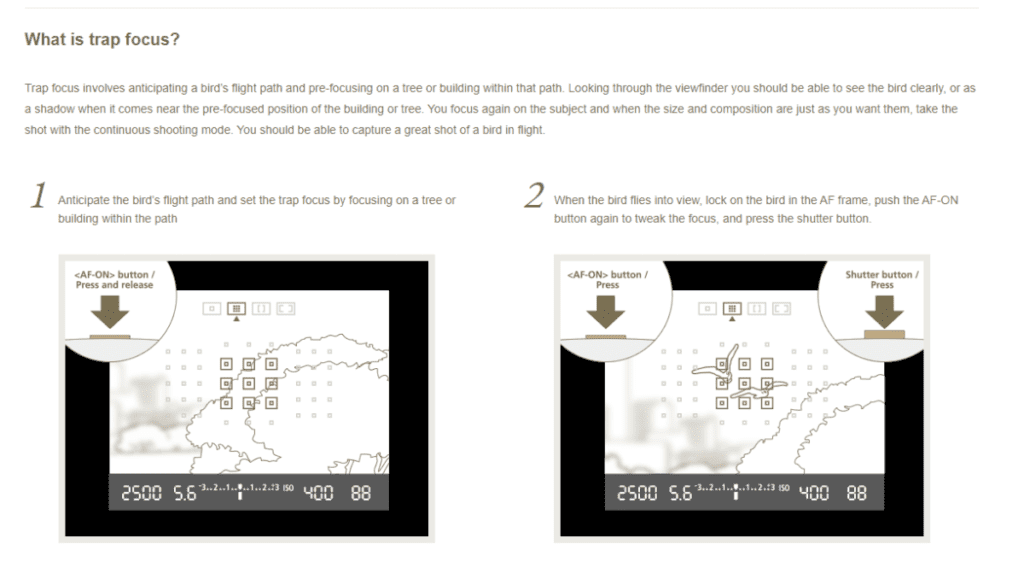
If you’re looking to identify birds in flight, but just can’t seem to pick out their features using your binoculars, you can consider learning how to photograph birds in flight. Taking pictures of birds isn’t easy as it isn’t always still, but you get to slowly pick out its features and identify them in the comfort of your homes after!
Link: https://global.canon/en/environment/bird-branch/how-to-photograph-birds/lesson15/index.html
Final Thoughts
Now that you’ve learned a thing or two about identifying birds in flight, go on and use your knowledge to identify that darn flying bird you’ve always wanted to do so! This process of identifying birds in flight isn’t necessarily easy, but hopefully, this article has helped out. All the best in your birding attempts and happy birding!
References
- [1] Laybourne, Roxie C. (December 1974). “Collision between a Vulture and an Aircraft at an Altitude of 37,000 Feet”. The Wilson Bulletin. Wilson Ornithological Society. 86 (4): 461–462. ISSN 0043-5643. JSTOR 4160546. OCLC 46381512
- [2] Carwardine, Mark (2008). Animal Records. Sterling. p. 124. ISBN 1402756232.
My Recommended Birding Resources:
Hey there, Justin here!
Here’s a list of all my favorite resources, products, and brands I trust and love.
My Celestron Nature DX 8×42 Binoculars: It’s a great budget pair for beginner birders. Highly valued for its price! Read my review.
Safe Paint for Bird Baths Guide: Learn about non-toxic paint for painting bird baths.
Safe Sealers for Bird Baths Guide: Learn which sealers are safe for bird baths.
Safe Paint for Bird Feeders Guide: Learn what special care needs to be taken to paint bird feeders with the right paint.
Safe Paint for Birdhouses Guide: Learn about non-toxic paint for painting birdhouses. (Not the same as bird baths!)
Bird Identification Apps Guide: 2 of my favorite birding apps are Merlin Bird ID, and eBird Mobile! Merlin is great for tracking and identifying birds, and eBird Mobile is great for tracking the birds sighted when birding.
Check out my resources page for the full list of resources I recommend!

Justin Chia
Justin is the founder and author of Birding Outdoors. He is a Nanyang Technological University (NTU) alumnus with a Bachelor of Biological Sciences and a former data analyst.
Now, Justin runs the Birding Outdoors blog full-time, hoping to share his deep love for birds, birding, and nature with others.
To unwind, Justin enjoys gaming and reading.

